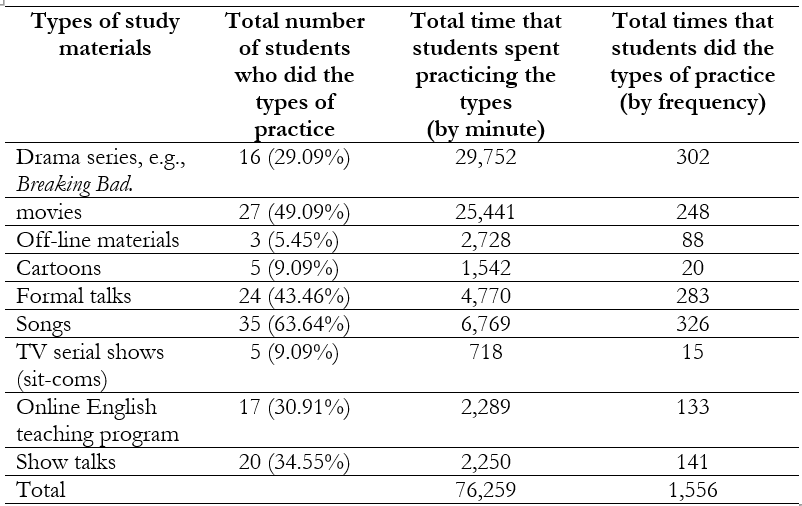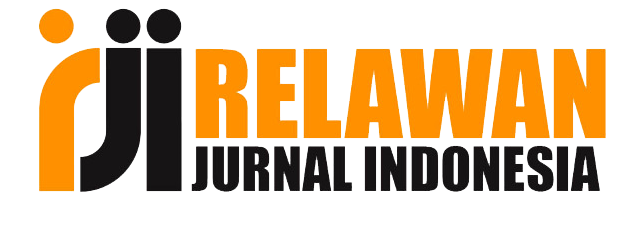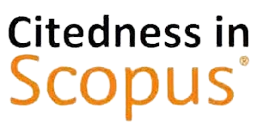The multidimensional effects of extensive listening on EFL learners
DOI:
https://doi.org/10.33474/j-reall.v5i1.21190Keywords:
ELT, extensive listening, listening and viewing, second language listeningAbstract
This study investigated the multidimensional effects of extensive listening (EL) on learners’ actual language gains, selection of study materials, and practice styles. Language gains were measured through a pre- and a post-test on students’ aural vocabulary test (Listening Vocabulary Levels Test, LVLT) and general listening comprehension (TOEIC), administered before and after the intervention. Fifty-five university student participants took part in the four-month experiment; they were entirely free to select their favorite study materials online or off-line. The results showed that each student spent an average of 1,387 minutes (approximately 87 minutes per week) doing EL practice. The three most popular study materials were the following: Songs (63.64%), movies (49.09%), and talks (43.46%); materials were mainly from YouTube (74.55%), Netflix (49.09%), and other miscellaneous sources (43.63%). Their practice style was unanimously a combination of viewing and listening. From the pre-tests to the post-tests, students made significant gains in both LVLT and TOEIC, but the effect sizes were small. Some suggestions are made for implementing EL.
References
Bozan, E. (2015). The effects of extensive listening for pleasure on the proficiency level of foreign language learners in an input-based setting [Master’s Thesis, University of Kansas]. UK Campus Repository. https://kuscholarworks.ku.edu/handle/1808/21594
Brown, R. (2007). Extensive listening in English as a foreign language. The Language Teacher, 31(12), 15-19.
Çakır, I. (2018). Is listening instruction neglected intentionally or incidentally in foreign language teaching contexts? Journal of Language and Linguistic Studies, 14(2), 154-172.
Chang, A. C.-S. (2009). Gains to L2 listeners from reading while listening versus listening only in comprehending short stories. System, 37(4), 652–63.
Chang, A. C.-S. (2011). The effect of reading while listening to audiobooks: Listening fluency and vocabulary gain. Asian Journal of English Language Teaching, 19, 43–64.
Chang, A. C.-S. (2012). Gains to L2 learners from extensive listening: Listening development, vocabulary acquisition and perceptions of the intervention. Hong Kong Journal of Applied Linguistics, 14(1), 25-47.
Chang, A. C.-S., & Millett, S. (2014). The effect of extensive listening on developing L2 listening fluency: Some hard evidence. ELT Journal, 68(1), 31–40. doi:10.1093/elt/cct052
Chang, A. C.-S., & Millett, S. (2016). Developing L2 listening fluency through extended listening-focused activities in an extensive listening programme. RELC Journal, 47(3), 349–362. doi:10.1177/0033688216631175
Chang, A. C.-S., Millett, S., & Renandya, W. A. (2019). Developing listening fluency through supported extensive listening practice. RELC Journal, 50(3), 422-438. https://doi.org/10.1177/0033688217751468
Chen, C. W. Y. (2016). Listening diary in the digital age: Students' material selection, listening problems, and perceived usefulness. JALT CALL Journal, 12(2), 83-101.
Du, G., Hasim, Z., & Chew, F. P. (2022). Contribution of English aural vocabulary size levels to L2 listening comprehension. International Review of Applied Linguistics in Language Teaching, 60(4), 937-956. https://doi.org/10.1515/iral-2020-0004
Gavenila, E. I., Wulandari, M., & Renandya, A. W. (2021). Using TED talks for extensive listening. PASAA, 61(1), 147-175.
Ivone, F. M., & Renandya, W. A. (2019). Extensive listening and viewing in ELT. TEFLIN Journal, 30(2), 237–256. https://doi.org/10.15639/teflinjournal.v30i2/237-256
Jeon, E. H., & Yamashita, J. (2014). L2 reading comprehension and its correlates: A meta-analysis. Language Learning, 64(1), 160-212.
Kartal, G., & Simsek, H. (2017). The effects of audiobooks on EFL students’ listening comprehension. The Reading Matrix, 17(1), 112-123.
Ly, N. N., & Nga, N. T. (2020). An investigation into the effects of extensive listening on pre-intermediate learners’ English vocabulary learning at The Asian International School. Ho Chi Minh City Open University Journal of Science, 10(1), 3-17. DOI:10.46223/HCMCOUJS.soci.en.10.1.552.2020
Masrai, A. (2020). Exploring the impact of individual differences in aural vocabulary knowledge, written vocabulary knowledge and working memory capacity on explaining L2 learners’ listening comprehension. Applied Linguistics Review, 11(3), 423-447. https://doi.org/10.1515/applirev-2018-0106
Mayora, C. A. (2017). Extensive listening in a Colombian university: Process, product, and perceptions. How, 24(1), 101-121.
McLean, S., Kramer, B., & Beglar, D. (2015). The creation and validation of a listening vocabulary levels test. Language Teaching Research, 19(6), 741-760.
Milliner, B. (2017). Five online resources for extensive listening in the Japanese EFL classroom. Accents Asia, 9(2), 1-10.
Milton, J. & Hopkins, N. (2005). Aurallex. Swansea, UK: Swansea University
Nation, I. (2006). How large a vocabulary is needed for reading and listening? Canadian Modern Language Review, 63(1), 59–82. https://doi.org/10.3138/cmlr.63.1.59
Nugroho, D. Y. (2020). EAP students’ perceptions of extensive listening. Journal of English Language, Literature, and Teaching, 4(1), 95-106.
Onoda, S. (2012). The effect of QuickListens and extensive listening on EFL listening skill development. Extensive Reading World Congress Proceedings, 1, 176-179.
Plonsky, L., & Oswald, F. L. (2014). How big is “Big”? Interpreting effect sizes in L2 research. Language Learning, 64(4), 878–912. doi:10.1111/lang.12079
Renandya, W. A. (2011). Extensive listening in the language classroom. In H.P. Widodo & A. Cirocki (eds.), Innovation and creativity in ELT methodology. New York: Nova Science Publishers.
Robb, T. (2002). Extensive reading in an Asian context—An alternative view. Reading in a Foreign Language, 14(2): 146-147.
Rost, M. (2002). Teaching and Researching Listening. London: Pearson Education.
Singh, A., & Alexander, P. A. (2022). Audiobooks, print, and comprehension: What we know and what we need to know. Educational Psychology Review, 34, 677 - 715.
Tagane, Y., Naganuma, N., & Dougherty, P. (2018). Academic dishonesty in extensive reading programs: Stories and strategies from student interviews. The Language Teacher, 42(1), 9-12. Retrieved from https://www.jalt-publications.org/node/2/articles/24084.
Tragant, E., & Vallbona, A. (2018). Reading while listening to learn: Young EFL learners’ perceptions. ELT Journal. 72(4), 395-404. doi:10.1093/elt/ccy009
Tsang, A. (2022). Effects of narrow listening on ESL learners’ pronunciation and fluency: An ‘MP3 flood’ programme turning mundane homework into an engaging hobby. Language Teaching Research, 26(3), 434-454. https://doi.org/10.1177/1362168819894487
van Zeeland, H., & Schmitt, N. (2013). Incidental vocabulary acquisition through L2 listening: A dimensions approach. System, 41(3), 609-624.
Verdugo, D. R., & Belmonte, I. A. (2007). Using digital stories to improve listening comprehension with Spanish young learners of English. Language Learning & Technology, 11(1), 87–101. http://dx.doi.org/10125/44090
Yonezawa, M., Kurihara, Y., & Durand, J. (2013). Exploring extensive listening with graded-reader CDs. In N. Sonda & A. Krause (Eds.), JALT2012 Conference Proceedings. Tokyo: JALT, 383-392.

Downloads
Published
How to Cite
Issue
Section
License
Copyright (c) 2023 Anna C-S Chang, Willy Ardian Renandya

This work is licensed under a Creative Commons Attribution 4.0 International License.
Authors who publish this journal agree to the following terms:
- Authors retain copyright and grant the journal right of first publication with the work simultaneously licensed under a Creative Commons Attribution License that allows others to share the work with an acknowledgement of the work's authorship and initial publication in this journal.
- Authors can separately make additional contractual arrangements for non-exclusive distribution published by the journal (e.g., publish it in a book), with an acknowledgement of its initial publication in this journal.
- Authors are allowed and encouraged to send their work via online (e.g., in the institutional repositories or their website) after published by the journal.





















